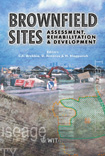Accelerating Pollutant Release From Mud Bed By Sand Drains
Price
Free (open access)
Transaction
Volume
55
Pages
Published
2002
Size
315 kb
Paper DOI
10.2495/BF020501
Copyright
WIT Press
Author(s)
C. J. Lai, J. M. Leu & H. C. Chan
Abstract
It is proposed to use sand drain systems in a channel mud bed to accelerate the pollutants release rate of the mud bed, based on the fact that the hydraulic conductivity of mud in the horizontal is usually larger than that of the vertical. Experiments are conducted in model channel bed system to assess this concept. This model is filled with various mud depths and has different sand drain arrangements. Ammonium nitrogen (NH4-N) and dissolved oxygen (DO) concentrations at the water body adjacent to the mud surface are measured. Experimental results show that the ammonium nitrogen concentration increases with the test time. It's release rate increases with intensity of the sand drains. Deployment of a sand drain system is proved to be useful in accelerating the releasing of mud- trapped pollutant. 1 Background To restore both the water body and the bottom to a better condition that some engineering measures, such as dredging or consolidating the bottom material, are usually needed. Owing to the property of the accumulation and consolidation of the sediment and some side effects of the measures, the required purification objective may not be achieved. The slow release of the embedded pollutants is part of the reason for the failure of the measures. A proposal is made that uses sand drain system to accelerate the release of the embedded pollutant is depicted in Fig. 1. This is based on the fact that the horizontal conductivity in mud is usually larger than that of the vertical. The system collects the horizontal pollutant flow and diffuses it upward through the pore water in the sand drain.
Keywords




